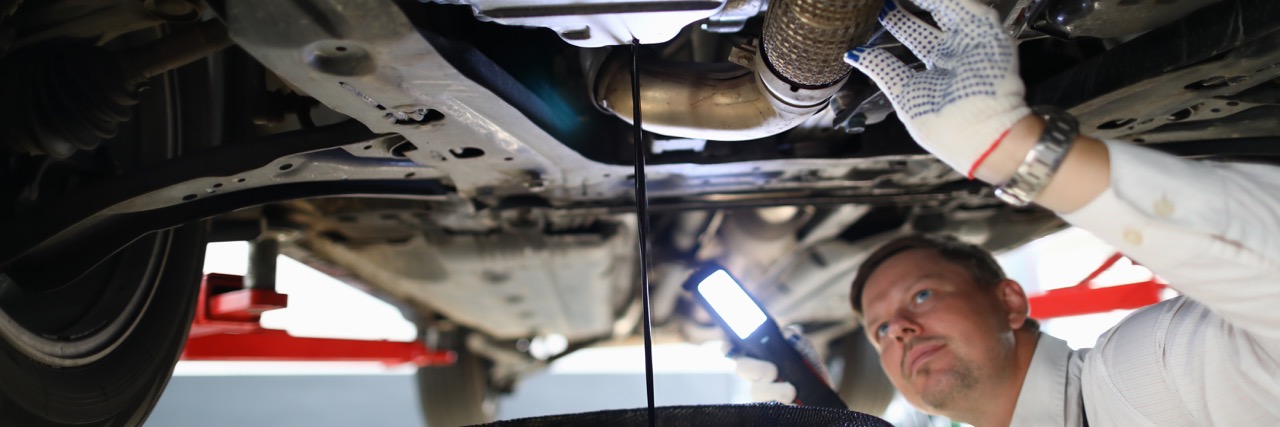
Your car’s engine runs on various liquids—gasoline, engine oil, coolant, brake fluid, and power steering fluid are among the most important—that lubricate moving parts, drive accessories, and reduce engine friction. But if you’ve pulled away from the driveway and noticed steam or liquid under your car, you may have an oil leak to worry about. So although we’ll mostly talk about engine oil leaks today, we’ll also touch on the above liquids, how to spot an issue, and what to do once you have.
Liquids Your Vehicle Needs:
If you’ve spotted an oil leak, but your car is running normally, it still may be safe to drive. But don’t put off repairs till the last minute. Here are a few fluid leaks you should pay attention to.
- Steering Fluid Leak. This type of leak is typically seen at the front end of your car. If you see a reddish-brown fluid on the thinner side, that’s likely steering wheel fluid. If you haven’t spotted a leak, but your steering wheel is shaky, squeaky, or suddenly difficult to turn, it could be a lack of steering wheel fluid.
- Antifreeze Fluid Leak. If you’ve noticed a thick yellow, pink, or green patch of fluid under your car, it’s likely antifreeze. This fluid is vital to your car’s health throughout the year, not just in winter. It helps prevent rust build-up, aids in heat transfer, and protects your engine from corrosion.
- Water Leak. Water is necessary to keep your vehicle cool as it’s working. If you have a leak, you’re most likely to see a clear pool of condensation or water under your car.
- Transmission Fluid Leak. This one can be harder to catch, but if your car has been parked for a bit of time, you might notice a thick patch of brown or red fluid around the mid-section of your car. This fluid keeps your car’s transmission cool and lubricated. If you see a leak, get it fixed quickly!
- Brake Fluid Leak. This can be easier to catch. If you see an oily patch leaning from clear to brown near the passenger side seat or around your car’s wheels, it is a sure sign of a brake fluid leak. This fluid provides the force you feel when applying pressure to your brake pedal.
How to Catch an Engine Fluid Leak
If you’re paying attention, you may be able to catch an oil leak before it becomes a significant problem. For example, if you see engine oil on your driveway or garage floor or notice the level of your oil dropping too quickly between changes, you’re probably leaking oil.
Oil leaks can be hard to spot; as we mentioned above, even if you don’t see oil dripping from your vehicle or staining the pavement below it, there are still a few telltale signs that indicate an issue. One of them is smoke—if your car’s exhaust emits white smoke (often described as “smelling like burnt marshmallows”) or light blue, then oil has likely seeped into the combustion chamber and is burning off. Other indicators include burning smells and fluid leaks in general.
Where Is the Leak?
While there are several ways for oil to leak out of an engine, the most common culprits are the oil filter or drain plug (or both), the valve cover gaskets, and the oil pan gasket. You may not even need to get underneath your car’s hood to start this process. Oil leaks tend to make their presence known by leaving a sticky mess under the car wherever you park, and you can use this to pinpoint your issue.
Oil leaks are more common in older cars, but they can happen in any year, make, or model. If you’re able to spot an issue early on, you may be able to stop it before it becomes a much bigger problem. However, if you’re unsure if a leak is coming from your car, it’s best to bring your vehicle in for a routine tune-up right away. Although you can drive with a leak present, it can cause significant damage if not cared for promptly.
Related Posts
Key Takeaways On average, passenger vehicle tires last 40,000 to 60,000 miles, depending on type, driving habits, and maintenance. Replace tires when tread depth reaches 2/32”, if damaged, or older than 10 years. Regular rotation, alignment, and proper inflation extend tire life. Aggressive driving, poor roads, and harsh weather shorten tire lifespan. Take advantage [...]
When you think about car maintenance, you probably focus on oil changes, tire rotations, and maybe even brake pad replacement. But what about your brake fluid? If you’ve ever wondered, “What does brake fluid do?” or “Why is brake fluid important?”, you’re not alone. Brake fluid might not be the most talked-about part of [...]
Is that high-pitched squeal from your brakes driving you—and everyone else—crazy? Don’t ignore it. Squeaky brakes aren’t just annoying, they’re your car’s way of saying something needs attention. Whether you're cruising through Salt Lake City or winding up Idaho’s mountain passes, here’s what’s likely going on, how you can fix it, and when it [...]





